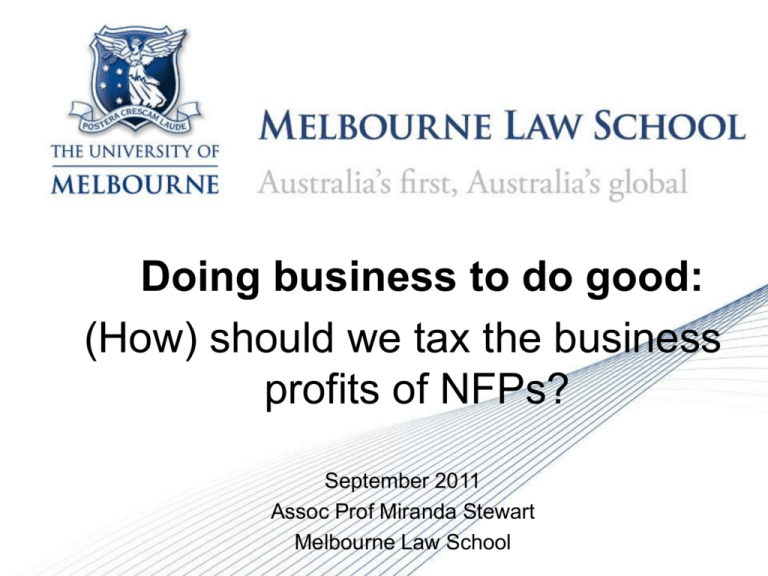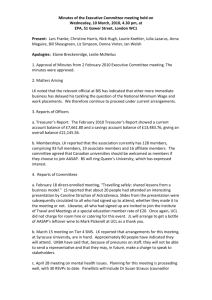Taxation Issues for Not-For-Profit Organisations
advertisement

Doing business to do good: (How) should we tax the business profits of NFPs? September 2011 Assoc Prof Miranda Stewart Melbourne Law School 1 Sources of Income of NFPs 18000 Government funding 16000 Other 14000 12000 $m 10000 Membership fees Donations, sponsorships and fundraising 8000 Rent, leasing and hiring 6000 Investment income 4000 2000 Income from related or affiliated organisations Income from services 0 Sales of goods 2 Extent of business activity • Finding Australia’s Social Enterprises Sector Report – Australian Centre for Philanthropy and Nonprofit Studies, Queensland University of Technology, June 2010, surveyed 539 organisations mostly in education, arts and recreation • 64.9% conducted only one commercial venture. • Principal commercial activity was to charge fees for services (62.7%), other categories (ranging from 20-26%) including sale and production of goods, use of capital assets for a fee, government or other contracts, and providing a mechanism for others to sell goods. • 68.5% conducted business in incorporated or registered trading entities. • 90% invested all of the profits back into the mission. 3 Tax of business activity of NFPs • Recent case law – Word Investments [2008] HCA; Wentworth District Capital [2011] FCAFC 42; Co-operative Bulk Handling [2010] FCAFC 155 • ATO position – Draft TR 2011/D2 – TR 2005/21; TR 2005/22; TR 2000/11 • Henry Tax Review • Treasury Consultation Paper, 27 May 2011 – Better Targeting of Tax Concessions 4 Word Investments • “[W]hen the 16 purposes enumerated in sub-cl 3(a)(i)-(xvi) are read as a whole, each of them on its true construction states a charitable purpose – a purpose of advancing religion in a charitable sense. Those which taken separately are beyond that purpose are to be read down as being within it.” • Sub-cl 3(a)(xvii) and (c)-(ak) need to be read in light of subcl 3(b): "To carry on any business or activity which may seem to the Company capable of being conveniently carried on in connection with the objects for which this Company is established." • For the most part it is sub-cl 3(a) which states the company's purposes, not sub-cll 3(b)-(ak), which perform another function. That is confirmed by the radical difference between the matters listed in sub-cl 3(a)(i)-(xvi) and the matters listed in sub-cll 3(a)(xvii) and (b)(ak). The former can truly be described as purposes, while the latter are not to be construed as purposes at all, but rather as powers. “ 5 [24] “It is therefore necessary to reject the Commissioner's arguments so far as they submitted that Word had a "commercial object of profit from the conduct of its business" which was "an end in itself" and was not merely incidental or ancillary to Word's religious purposes. Word endeavoured to make a profit, but only in aid of its charitable purposes. To point to the goal of profit and isolate it as the relevant purpose is to create a false dichotomy between characterisation of an institution as commercial and characterisation of it as charitable.” 6 TR 2011/D5 58. A purpose of carrying on a business or commercial enterprise to generate a surplus where that purpose is an end in itself is not charitable. 59. However, commercial or business-like activities can be compatible with a charitable purpose. An institution undertaking commercial or business-like activities can be charitable if: • its sole purpose is charitable and it carries on a business or commercial enterprise to give effect to that charitable purpose. In these circumstances it does not matter that the activities themselves are not intrinsically charitable; • it has a business or commercial purpose that is simply incidental or ancillary to its charitable purpose; • its activities are intrinsically charitable but they are carried on in a commercial or business-like way; or • it holds passive investments to receive a market return to further its charitable purpose. 7 Treasury Proposal • The Government will reform the tax concessions provided to NFP entities to ensure they are targeted only at those activities that directly further an NFP’s altruistic purposes. • Income tax concessions will only apply to profits generated by the unrelated commercial activities of NFPs, if they are directed to the NFP’s altruistic purpose. – An NFP will pay income tax on the earnings it retains in its commercial undertaking • An NFP entity will also not have access to a FBT exemption or rebate, GST concessions or DGR support in relation to their unrelated commercial activities. 8 Exclusions • • • • • “Small-scale” unrelated commercial activities “Low risk” unrelated commercial activities. “Passive” income Mutual income and the principles of mutuality. Commencement – Initially only new unrelated commercial activities that commence after 7:30 pm (AEST) on 10 May 2011 – Potential rules to bring existing unrelated commercial activities into the net in future 9 Treasury Proposal • 3 possible options 1. NFPs required to conduct taxable unrelated business in a separate taxable entity, that returns profits to NFP by deductible gift; refund of franking credits etc 2. NFP is taxed on retained profits of a taxable business at end of year in special regime 3. NFP required to account separately for unrelated business even though conducted in its own structure • Currently, company imputation system provides refund of franking credit for eligible “exempt institutions”: Div 67 and s 207-115 of ITAA 1997 10 Charity owns separate taxable company Public benefit Option 2: Could pay deductible rent (land leased from institution) Tax-exempt institution Taxable Business Co Pty Ltd Exempt from tax; franking credit refund may be available Option 1: Pay franked dividend Australian source profits on business activity Company tax paid at 30% rate on taxable income 11 Principle/policy reasons • Competitive neutrality “level playing field” • Charitable “altruistic” purpose should be the primary focus of the entity • Target the tax concession to “directly support altruistic purposes”(cost to revenue) • Protect NFP assets from “unnecessary commercial risks” • Promote “efficient use of resources for altruistic purposes” 12 Local Govt rates exemptions • Victoria Local Govt Act 1989 – Land must be used “exclusively” for charitable purposes – And is not exempt if “(d) it is used to carry on a business for profit (unless that use is necessary for or incidental to a charitable purpose).” 13 Comparative jurisdictions • • • • United Kingdom New Zealand Canada United States 14 United Kingdom • Charitable companies: Corporations Tax Act 2010 • Same provisions in Income Tax Act 2007 for charitable trusts Exemption for profits etc of charitable trades (s 478) • • • • • (1) The income mentioned in subsection (2) is not taken into account in calculating total profits if the condition in subsection (3) is met. (2) The income referred to in subsection (1) is– (a) profits of a charitable trade carried on by a charitable company, and (b) post-cessation receipts arising from a charitable trade carried on by a charitable company which are received by the company or to which it is entitled. (3) The condition is that the profits are, or (as the case may be) the post-cessation receipt is, applied to the purposes of the charitable company only. 15 United Kingdom Meaning of "charitable trade“ (s 479) (1) For the purposes of this Part a trade carried on by a charitable company is a charitable trade if– (a) the trade is exercised in the course of carrying out a primary purpose of the charitable company, or (b) the work in connection with the trade is mainly carried out by beneficiaries of the charitable company. (2) For the purposes of subsection (1)(a), if a trade is exercised partly in the course of carrying out a primary purpose of the charitable company and partly otherwise, each part is to be treated as a separate trade. (3) For the purposes of subsection (1)(b), if work in connection with a trade is carried out partly but not mainly by beneficiaries, the part in connection with which work is carried out by beneficiaries and the other part are to be treated as separate trades. (4) If different parts of a trade are treated as separate trades under subsection (2) or (3), a just and reasonable apportionment is to be made for that purpose of– (a) expenses and receipts of the trade, and (b) any amounts which are post-cessation receipts arising from the trade for the purposes 16 of Part 3 of CTA 2009. United Kingdom Exemption for profits of small-scale trades (s 480) (1) The income mentioned in subsection (2) is not taken into account in calculating total profits if conditions A and B are met. … (4) Condition A is– (a) in the case of the profits of a trade, that the profits are profits of an accounting period in relation to which the condition specified in section 482 (condition as to trading and miscellaneous incoming resources) is met, and (b) in the case of a post-cessation receipt, that it is received in such an accounting period. (5) Condition B is that the profits are, or (as the case may be) the receipt is, applied to the purposes of the charitable company only. (6) The exemption under subsection (1) requires a claim. (7) In this section "post-cessation receipt" means an amount that is a post-cessation receipt for the purposes of Part 3 of CTA 2009 (see sections 190 to 195 of that Act). 17 New Zealand Income Tax Act 2007 Part C Income, Subpart CW—Exempt income CW 41 Charities: non-business income (1) The following are exempt income: (a) an amount of income derived by a trustee in trust for charitable purposes: (b) an amount of income derived by a society or institution established and maintained exclusively for charitable purposes and not carried on for the private pecuniary profit of any individual. Exclusion: business income (3) This section does not apply to an amount of income derived from a business carried on by, or for, or for the benefit of a trust, society, or institution of a kind referred to in subsection (1). 18 CW 42 Charities: business income Exempt income (1) Income derived directly or indirectly from a business carried on by, or for, or for the benefit of a trust, society, or institution of a kind referred to in section CW 41(1) is exempt income if— (a) the trust, society, or institution carries out its charitable purposes in New Zealand; and (b) the trustee or trustees of the trust, the society, or the institution is or are, at the time that the income is derived, a tax charity; and (c) no person with some control over the business is able to direct or divert, to their own benefit or advantage, an amount derived from the business. … 19 Canada Section 149.1(2)(a) and (3)(a) Revocation of registration • The Minister may revoke the registration of a charity or public foundation where it “carries on a business that is not a related business of that charity” • Applies to charities and public foundations (private foundations are prohibited from carrying on business) • “related business”, in relation to a charity, includes a business that is unrelated to the objects of the charity if substantially all persons employed by the charity in the carrying on of that business are not remunerated for that employment; 20 Revenue Canada Interpretation Policy Statement: What is a Related Business? CPS-019 2003 • There are two kinds of related businesses: – businesses that are run substantially by volunteers; and – businesses that are linked to a charity's purpose and subordinate to that purpose. • The Income Tax Act says that charities can lose their registration if they carry on an unrelated business. By implication, the law allows them to carry on a related business. • Charity law, reinforced by provisions in the Income Tax Act, requires that charities have exclusively charitable purposes. Running a business cannot become a purpose in its own right—it must remain subordinated to the organization's charitable purpose. 21 United States TITLE 26 > Subtitle A > CHAPTER 1 > Subchapter F PART III—TAXATION OF BUSINESS INCOME OF CERTAIN EXEMPT ORGANIZATIONS § 511. Imposition of tax on unrelated business income of charitable, etc., organizations § 512. Unrelated business taxable income § 513. Unrelated trade or business § 514. Unrelated debt-financed income 22 Section 512 (a) General Rule Except as otherwise provided in this subsection, the term "unrelated business taxable income" means the gross income derived by any organization from any unrelated trade or business (as defined in section 513) regularly carried on by it, less the deductions allowed by this chapter which are directly connected with the carrying on of such trade or business, both computed with the modifications provided in subsection (b). Sec. 513. Unrelated trade or business (a) General rule The term "unrelated trade or business" means … any trade or business the conduct of which is not substantially related (aside from the need of such organization for income or funds or the use it makes of the profits derived) to the exercise or performance by such organization of its charitable, educational, or other purpose or function constituting the basis for its exemption under section 501 23 Sec 512 (b) … There shall be excluded all dividends, interest, payments with respect to securities loans (as defined in subsection (a)(5), amounts received or accrued as consideration for entering into agreements to make loans, and annuities, and all deductions directly connected with such income. … There shall be excluded all royalties (including overriding royalties) whether measured by production or by gross or taxable income from the property, and all deductions directly connected with such income. … In the case of rents— … there shall be excluded— (i) all rents from real property …, and (ii) all rents from personal property (including for purposes of this paragraph as personal property any property described in section 1245(a)(3)(B)) leased with such real property, if the rents attributable to such personal property are an incidental amount of the total rents received or accrued under the lease, determined at the time the personal property is placed in service. 24 Sec 513 (c) Advertising, etc., activities For purposes of this section, the term "trade or business" includes any activity which is carried on for the production of income from the sale of goods or the performance of services. For purposes of the preceding sentence, an activity does not lose identity as a trade or business merely because it is carried on within a larger aggregate of similar activities or within a larger complex of other endeavours which may, or may not, be related to the exempt purposes of the organization. Where an activity carried on for profit constitutes an unrelated trade or business, no part of such trade or business shall be excluded from such classification merely because it does not result in profit. 25 Section 513 … except that such term does not include any trade or business— (1) in which substantially all the work in carrying on such trade or business is performed for the organization without compensation; or (2) which is carried on … by the organization primarily for the convenience of its members, students, patients, officers, or employees …; or (3) which is the selling of merchandise, substantially all of which has been received by the organization as gifts or contributions. …. … qualified public entertainment activities or conventions and trade shows … Certain hospital services … Certain bingo games … Certain distributions of low cost articles without obligation to purchase and exchanges and rentals of member lists … 26






